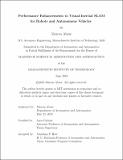Performance Enhancements to Visual-Inertial SLAM for Robots and Autonomous Vehicles
Author(s)
Abate, Marcus
DownloadThesis PDF (16.78Mb)
Advisor
Carlone, Luca
Terms of use
Metadata
Show full item recordAbstract
Spatial perception is a key enabler for effective and safe operation of robots and autonomous vehicles in unstructured environments. Two key components of a complete spatial perception system are: identifying where the robot is in space, and constructing a representation of the world around the robot. In this thesis, we study Visual-Inertial Simultaneous Localization and Mapping (VI-SLAM) and present several findings on its application to a variety of robotic platforms to obtain globallyconsistent localization for a robot as well as a dense map of its surroundings. In particular, we extend Kimera, an open-source VI-SLAM pipeline, to be more effective in traditional use-cases (e.g., stereo-inertial VI-SLAM) as well as more broadly applicable to different platforms and sensor modalities.
Our first contribution is to present a system built around Kimera for autonomous valet parking of self-driving cars, and test on real-world self-driving car datasets. This system uses a modified version of Kimera to support multi-camera VI-SLAM and perform dense free-space mapping using multiple cameras with non-overlapping field of view. Our second contribution is to describe recent updates to Kimera and showcase their beneficial effect on localization and mapping performance, while also comparing against the state of the art on extensive datasets collected on a variety of platforms. Finally, we present a novel method for detecting and tracking humans in the scene in order to build 3D Dynamic Scene Graphs for high-level perception tasks, and evaluate our method in a photorealistic simulation environment. We conclude by commenting on the advantages of Kimera and identifying areas for future work.
Date issued
2023-06Department
Massachusetts Institute of Technology. Department of Aeronautics and AstronauticsPublisher
Massachusetts Institute of Technology